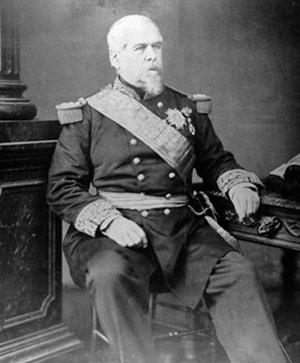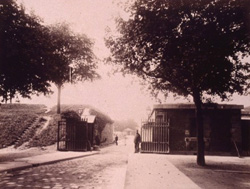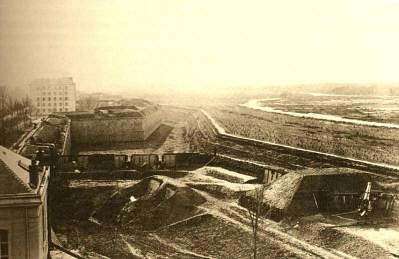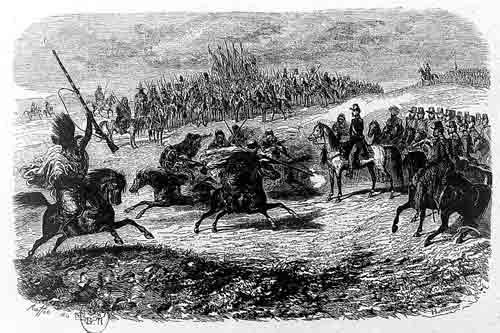François Chabaud-Latour

Son of Antoine Georges François (15 March 1769 - 19 July 1832) and of Julie Verdier de la Coste, François, Ernest Chabaud-Latour was born in Nîmes on 25 January 1804.
He graduated in seventh place from Ecole Polytechnique in 1820 and opted for Engineering. In 1829 he briefly took part, alongside the Russian army, in the siege of the fortified places of Danube, and was then called to Paris to serve in Polignac's ministry.
In 1830 he volunteered to leave for Algiers and was later decorated following the bombing of Fort de l'Empereur and the occupation of Blida.
Appointed Officer of Honour of the Duke of Orléans, a role he performed until the Prince's death in 1842, he took part in the campaign of Belgium and the taking of Antwerp. Chabaud-Latour also followed the Duke of Orléans during the Algeria campaigns (1837, 1839, 1840) and took part in events in Sig, Habra, Mascara, and then, in 1839, in the battle of Portes de Fer, which earned him the Officer's Cross of the Legion of Honour and, in 1840, in the combats of Medea, El-Affroun, Col de Mouzaïa and Bois des Oliviers.
In 1840, when the issue of fortifications for Paris was raised, he recommended, in his preliminary project, the construction of a continuous fortified wall and a ring of forts to protect the population from the rigours of a siege.
As deputy of the Gard (1837 to 1848, Guizot ministry) he was able to defend his project in front of Parliament.
As head of engineering, he personally took care of the Eastern sector of the Paris wall and supervised work until 1846.
He was promoted lieutenant-colonel in 1842 and became the aide-de-camp for the Count of Paris when the Duke of Orléans died. In 1846 he was made a Colonel and left to command the 3rd engineering regiment in Arras. In February 1848 he was still loyal to the Orléans family, to the point of offering to resign following the king's abdication. Placed on non-active status for a few weeks, he was called to the Amiens engineering department and then, following the coup d'état on 2 December 1851, he returned to his duties in Grenoble.
He was commander-in-chief of engineering in Algeria in 1852, where he remained for five years, taking part in the Babors expedition in 1853, the Beni-Iuya expedition in 1854, the Guetchoula expedition in 1855 and the Grande-Kabylie expedition in 1857. A talented planner, he built the Tizi-Ouzou to Souk-el-Arba road in 16 days and he had Fort-Napoléon built in four months, in the centre of the Béni Raten tribe. He also managed the building of dams on rivers and created several villages.
Brigadier General on 30 April 1853, Chabaud-Latour was promoted to Division General after the campaigns of 1857 and 1858, date of his return to Paris. He was called to the fortifications committee, to the general inspectorate of fortified places, engineering regiments and Ecole polytechnique, and to the advisory committee on Algerian affairs. During the war in Italy, he commanded the engineering corps posted on the Eastern frontier for observation duties. He became Grand Officer of the Legion of Honour in 1861, president of the fortifications committee in 1864, and then reserve cadre on 25 January 1869.
Called back to activity in 1870, Chabaud-Latour was put in charge of engineering of the Paris defence system and took over chairmanship of the fortifications committee. He renovated the capital's fortified camp so that it could only be bombed on its left bank from the unfinished redoubts of Châtillon and Montretout.
His son, Arthur Henri Alphonse (1839-1910), from his marriage with Hélène Mathilde Périer, a graduate of St Cyr, proved himself during battles of the Loire and received the Legion of Honour for his exemplary behaviour. Lissagaray wrote the following: "This Paris, for which Hoche, Marceau, Kleber would have been neither too young, nor too faithful, nor too pure, had for generals the residue of the Empire and Orleanism, Vinoy of December, Ducrot, Luzanne, Leflô, and a fossil like Chabaud-Latour."
The wall, commonly called the Thiers wall, measured 35 kilometres long (its line corresponds to the current ring road) and had 94 bastions, 17 doors and 8 sally-ports. In some parts, the base was made of 40 centimetres of concrete. The exterior pavement, like the side walls, was made of millstone and a succession of rubble bonded by hydraulic mortar. Appointed Grand Cross of the Legion of Honour for this, he was kept in activity with no age limit.
He was elected deputy of the Gard in February at the National Assembly – on the centre right – and chaired the army commission in charge of writing the 1872 military law. He was also rapporteur for the draft project on new forts to be built around Paris and was Vice-President of the Assembly several times. Chabaud-Latour was a member of the defence committee and put his talent to organising the new Eastern border.
An eminent character of the State, he was appointed in 1873 to judge Marshal Bazaine, accused of contributing to the defeat of France during the war between France and Germany in 1870.
Called on 20 July 1874 by Marshal de Mac-Mahon to Home Affairs duties until 10 March 1875, he supported the Duke of Broglie, in full debate concerning the seven-year plan. He failed in the Senate elections on 30 January 1876 but was appointed irremovable senator on 10 November in the following year.
He died in Paris on 10 June 1885 after falling down the stairs in the Compagnie des chemins de fer de l'Ouest, of which he was administrator.

Porte d'Arcueil. 1913. Eugène Atget. 16.8*21.8 cm. Source : BNF Poterne des peupliers. 1913. Eugène Atget. 16.8*21.8 cm. Source : BNF

Photographie d'une portion du mur d'enceinte de Paris. 1870. Source : SHD

Expédition des Portes de Fer. Source : Charles Nodier, Journal de l'expédition des Portes de Fer, Paris, Imprimerie royale, 1844 : p. 28

